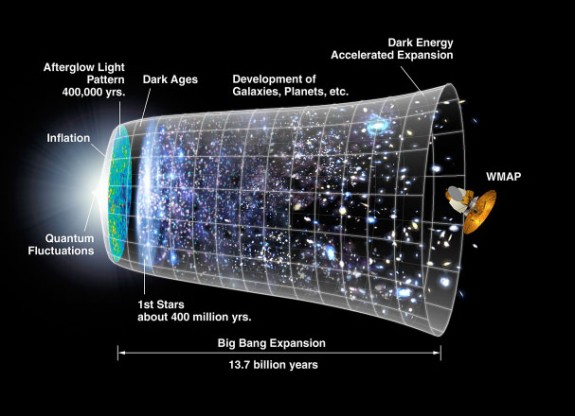One Physicist Thinks the Universe Is Not Expanding—And He Might Not Be Crazy
Christof Wetterich can also explain the “red shift” that supports the idea of the Big Bang

If one physicist’s idea holds out, big parts of this picture may have to be redrawn. Photo: NASA
BANG. From an infinitely dense, infinitely small speck of space, the entire universe emerged, and, ever since the Big Bang, space has been growing—expanding and cooling, producing matter and antimatter, atoms, stars and life. It’s the birth story of the universe. And, according to the story, space will continue to expand ever thus.
But there may be another way to explain what we see in the universe around us.
That’s the big idea of one physicist, Christof Wetterich, and, according to other physicists that Nature talked to, Wetterich’s critique of a canonical idea of modern physics might not be completely crazy.
Let’s back up for a minute. First, the idea of the expanding universe isn’t just some theoretical ideal that researchers concocted to balance an equation somewhere. Rather, there is real evidence out there in the world that we can see to support it. Nature:
Astronomers measure whether objects are moving away from or towards Earth by analysing the light that their atoms emit or absorb, which comes in characteristic colours, or frequencies. When matter is moving away from us, these frequencies appear shifted towards the red, or lower-frequency, part of the spectrum, in the same way that we hear the pitch of an ambulance siren drop as it speeds past.
In the 1920s, astronomers including Georges Lemaître and Edwin Hubble found that most galaxies exhibit such a redshift — and that the redshift was greater for more distant galaxies. From these observations, they deduced that the Universe must be expanding.
Roger Highfield for The Telegraph:
This idea might sound humdrum. But it marked the dawn of a revolutionary new view of the nature, origin, and fate of the universe, suggesting that billions of years ago, the universe must have been far denser than it is now, and that it started in a Big Bang.
Here’s how the classic example would play out for us here on the ground, as described by Minute Physics’ Henry Reich:
But Wetterich can also explain the “red shift.” He just goes about it in a different way.
Here’s his idea. Rather than space being slowly stretched out, everything in the universe has been slowly getting heavier. If, for some reason, everything has been getting more massive as the universe aged, the light produced by newer things would be more blue, and the light from old things would be more red. The Telegraph:
Prof Wetterich takes the detached, even playful, view that his work marks a change in perspective, with two different views of reality: either the distances between galaxies grow, as in the traditional balloon picture, or the size of atoms shrinks, increasing their mass. Or it’s a complex blend of the two. One benefit of this idea is that he is able to rid physics of the singularity at the start of time, a nasty infinity where the laws of physics break down. Instead, the Big Bang is smeared over the distant past: the first note of the ”cosmic piano’’ was long and low-pitched.
Wetterich’s theory wouldn’t throw out the Big Bang entirely, it would just re-tune it a little. All of this, of course, assumes that the theory holds up to any sort of strict test. For now, it’s just an idea, proposed by a researcher, written up in a paper and plopped online. In the coming days, months and years the idea will face harsh scrutiny. But if it pans out, this shift in perspective on the evolution of space could have who knows what kinds of consequences.
More from Smithsonian.com:
Stephen Hawking’s Initials in the Big Bang’s Echo
From the Big Bang to the End of the Earth and Everything in Between, the Two Minute History of America
/https://tf-cmsv2-smithsonianmag-media.s3.amazonaws.com/accounts/headshot/smartnews-colin-schultz-240.jpg)


/https://tf-cmsv2-smithsonianmag-media.s3.amazonaws.com/accounts/headshot/smartnews-colin-schultz-240.jpg)